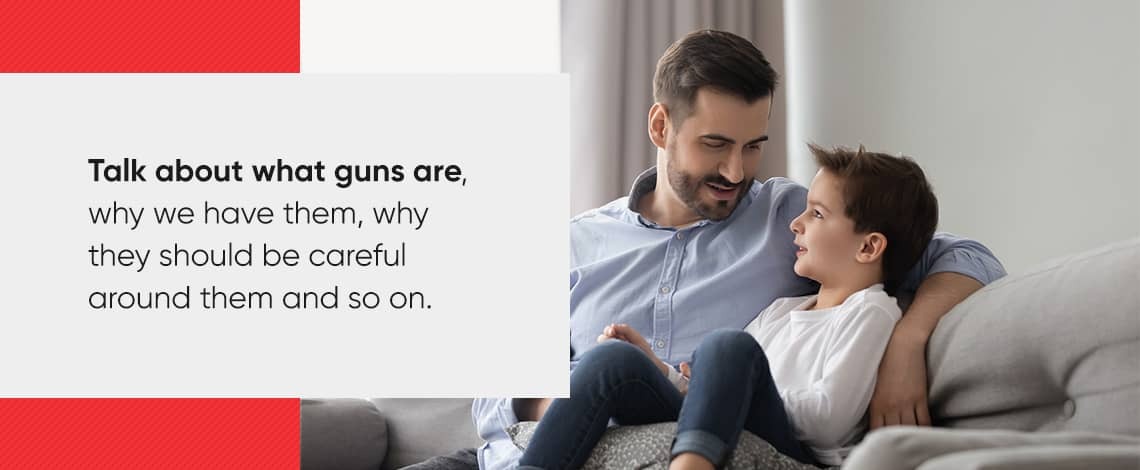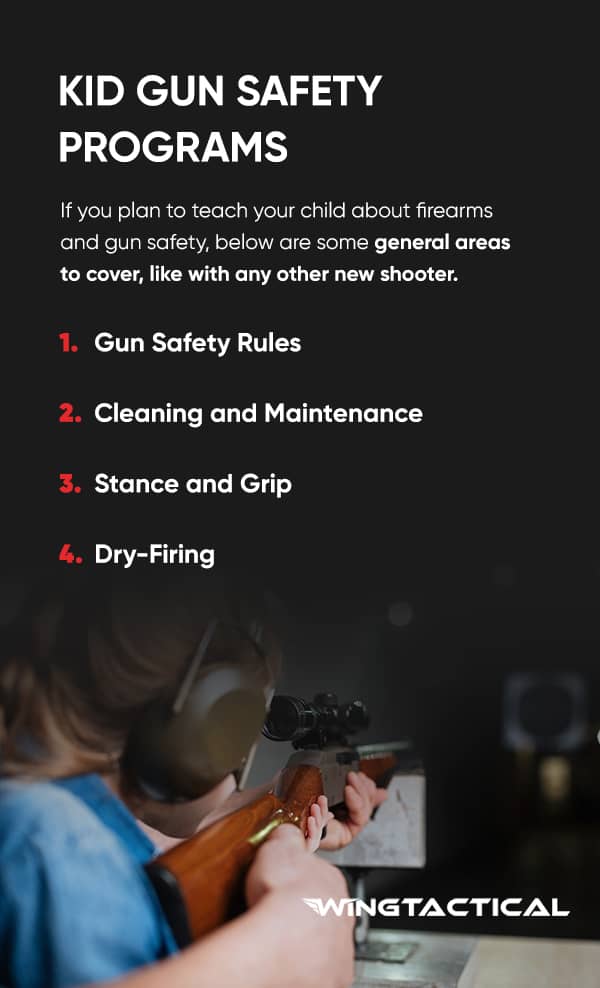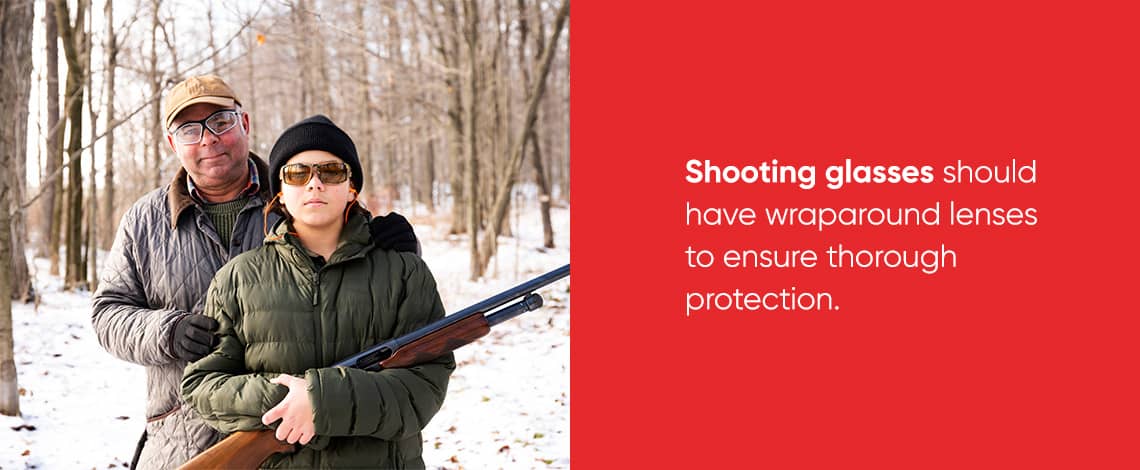 Kids that show interest in a particular subject — like guns — are capable of learning new concepts exceptionally quickly. So, the best time to teach your child about firearms is as soon as they express interest in them.
Kids that show interest in a particular subject — like guns — are capable of learning new concepts exceptionally quickly. So, the best time to teach your child about firearms is as soon as they express interest in them.
Even if they don't get here on their own, everyone who can learn about gun safety should do so. If one day, your child opts to go into law enforcement or invest in a gun for self-defense, having that foundational knowledge under their belt will be incredibly useful.
Learn how to explain guns to a child with the safety tips and recommendations below.
Why You Should Teach Your Kids About Guns
If you decide to keep a gun in your home, all other members of your household should be made aware of its presence — kids included. Talking to your children about guns helps them understand what they are and removes the mystery behind them. This, in turn, may prevent firearm-related incidents, as it removes the temptation a kid may otherwise feel to explore it.
At What Age Should I Teach My Child About Guns?
There isn't one blanket right answer to this question, as each child is different and develops at their own pace. Age doesn't always determine readiness — more often, the child's maturity does. A respectful 5-year-old that listens well to directions can likely grasp firearm safety basics, while a less mature 10-year-old child may not be ready for this step yet.
This is where using your own judgment and common sense comes in. If you believe your child is mentally mature enough to comprehend gun safety, then it's likely time to start teaching them. Children typically start demonstrating self-control, reasoning and good behavior at ages 6, 7 or 8.
What Should Kids Understand About Guns?

Before you start teaching your child things like gun safety, cleaning and proper firearm handling, the first step should be sitting down with them and having a conversation about the fundamentals. Talk about what guns are, why we have them, why they should be careful around them and so on. This is especially important if your child has little to no familiarity with guns.
Here are some important things children should understand about firearms.
1. A Gun Is Not a Toy
This is a no-brainer for grownups, but it isn't always evident to children right away. They may not understand just how powerful guns are quite yet, so it's important to educate them.
Help them understand how guns work and how dangerous they can be with irresponsible or improper handling. Stress that a firearm isn't a toy, but rather a tool that should be handled with extreme care, caution and respect.
That being said, don't instill a sense of nervousness or fear in your child when telling them about guns. While firearms can be dangerous, your child should also understand their value and how they can protect people. Explain that there's nothing to be afraid of as long as you handle a gun safely, carefully and wisely.
2. Why We Have Guns
Kids should also understand why guns exist and the purposes they serve. Explain the different reasons why someone might own a gun, like hunting, self-defense and sport activities like target practice and competitive shooting. While many of these activities can be recreational, make it clear that protection is the main role that guns fill.
3. What to Do if They Find an Unattended Gun
Your child should also know how to keep their calm around firearms — that way, if they're ever around one, they can react accordingly. Teach them to follow these rules if they see an unattended gun:
- Stop what they're doing.
- Don't touch the gun under any circumstances, even if it looks like a toy.
- Leave the area, then find a trustworthy adult to alert them of the gun.
Reinforce that playing with guns can have dangerous consequences, so they should only be handled by an adult or by a child of the right age with adult supervision.
Kid Gun Safety Programs

While many parents hesitate at the thought of introducing their children to guns, the truth is that young shooters can be just as safe as adult shooters. With plenty of training and a reliable mentor to show them the ropes of a firearm, they can build their skills as quickly and efficiently as a grownup.
If you plan to teach your child about firearms and gun safety, below are some general areas to cover, like with any other new shooter.
1. Gun Safety Rules
There are many gun safety lesson plans and resources available online, so you can easily find one to use for reference when teaching your child about firearm safety. You can even incorporate visuals, like PowerPoint slides and photos, to help them better understand the safety rules and make these lessons more engaging.
The four universal gun safety rules every shooter should follow are:
- Treat every gun like it's loaded.
- Never point the muzzle at anything you're not willing to destroy.
- Keep your finger off the trigger until you're ready to shoot the target.
- Always be sure of your target and what is beyond it.
That means your child should be mentally mature enough to understand and follow muzzle awareness.
2. Cleaning and Maintenance
After your child understands the basic gun safety rules, you can gradually start to introduce them to firearms.
Starting out small, like with basic cleaning and maintenance, is a good way to ease your child into the world of firearms — not to mention they can reach things you can't! Most children in this age group are naturally curious and want to get involved in whatever their parents are doing, even if that's something as simple as cleaning a gun.
Teaching your child how to clean a firearm also emphasizes the importance of using protective equipment and safe practices when performing this task. People of all ages should use goggles, gloves and proper ventilation when cleaning a gun, but it's especially vital for children. You also need to unload the gun and any live ammo in the chamber.
3. Stance and Grip
If your child is ready, you can introduce them to marksmanship basics, like proper shooting stance and grip. Having them practice on an empty pellet gun, BB gun, Airsoft gun or even a Nerf gun is a safe way to introduce these concepts.
Practice with them at home first before heading to the range. After having them handle a mock gun, you can have them try holding an empty firearm — remind them to keep their finger off the trigger.
It's going to be difficult for a small child to control a long, adult-sized gun. But a small, lightweight handgun makes it easy for them to swing around and flag someone. That's why as a parent, it's absolutely critical that you monitor their actions constantly, ensuring they're being safe and aren't taking on more than they're ready to handle.
4. Dry-Firing
Dry-firing is the practice of shooting a firearm with no ammo in the chamber. Once your child can comfortably hold and grip a firearm, have them practice dry-firing on a mock gun, then a firearm. When using an actual firearm, remember to triple-check that the gun is empty.
Caliber and Platform
There are varying opinions regarding what caliber is best to start your children with when teaching them how to shoot. But most can agree that you need to start them out small.
Once your child is proficient in shooting with a BB gun or air rifle, a .22-caliber rifle can be a good first-time firearm, as the recoil is generally manageable. Despite its size, it tends to be mild, easy to control and relatively quiet — so it may be less likely to create flinching habits. Remember that a smaller handgun doesn't always mean less muzzle rise and recoil.
The Rossi RS22 can be a great starter for kids and new shooters. It features a 10-round magazine so you can teach them to load and seat magazines. AR-15s can also make excellent teaching platforms — choose an option with minimal recoil to be a good starter for kids.
Because pistols can be harder to control and have a shorter sight radius, it's typically best to avoid starting with them. As your child starts to grow more comfortable shooting, you can start to shift from .22 and try out a larger 9mm. Find rifle options that offer less recoil and are slim enough for small hands.
You should also make sure the gun fits their hands properly. If it's too large, your child will have a more difficult time learning how to maneuver it. The key is to find a light, balanced firearm that's easy for a child to grip and handle. A comfortable firearm can help them feel more confident while shooting.
Provided you've already worked with your child on dry-firing empty guns, have them practice single-shot drills. Don't start them off with a loaded magazine. You should also start them off simple with bench rest shooting, then move them up to kneeling and standing.
Equipment Needed for Gun Safety
While every shooter needs some sort of hearing protection and glasses, these are especially important for kids as their eyes and ears are more sensitive. Without proper ear protection, exposure to firing noise can damage hearing.
Shooting glasses protect their eyes from twigs, leaves, blowback from excessive powder and rare ruptured cases or other firearm malfunctions. Their safety glasses and hearing protection should both fit comfortably and securely. Below are some recommended ear and eye protection for kids.
Ear Protection
While they work for many adults, standard foam earbuds likely won't be enough to guard your child's hearing. A pair of child-sized earmuffs is far more durable and protective. Better yet, they can use electronic muffs so they can hear you talking them through the steps.
Electronic earbuds are another option, but they're usually sized for adult ears, making muffs a more adjustable option. On another note, the benefit of teaching with smaller calibers is that they produce less noise.
Eye Protection

A quality pair of safety glasses is another essential for your child. If their eye protection is too big for their head, it won't stay in place and will be ineffective if something comes back toward their face.
Shooting glasses should have wraparound lenses to ensure thorough protection. The lenses should also be constructed from a durable material, like impact-resistant plastic or polycarbonate. These materials are more scratch-resistant and less likely to shatter with contact from flying debris.
Remember that different lens colors are suited for different conditions:
- Brown or amber: Brown is ideal for overcast days since it improves contrast and blocks out blue light.
- Orange or yellow: These colors are best for shooting early in the morning or late in the day. They enhance the color range for easier low-light shooting.
- Red: Red lenses are ideal for medium-light or bright, sunny days. They allow a small amount of visible light to pass through.
- Clear: Clear lenses tend to be the best all-around option, particularly when shooting outdoors in mild conditions.
- Polarized: Polarized lenses are great for dawn or dusk shooting, as they maximize contrast and reduce glare.
Gun Storage Tips
Storing a gun in your home requires extreme precaution — even more so when you have children. Gun safety education statistics show that about 4.6 million U.S. children live in homes where at least one firearm is stored loaded and unlocked. Take these steps to prevent your child from encountering a loaded gun in your home:
- Ensure the gun is unloaded and lock it up in a safe, vault, cabinet or case.
- Lock the ammo in a separate place from the gun.
- Don't give your child the keys or passcode to access the locked gun — keep these hidden.
- Install a trigger lock on the gun to prevent it from being fired.
Final Tips
You can explain gun safety to your child down to every last detail, but remember that they'll truly learn by watching you. If you want them to build good firearm habits, display them yourself. If you don't pay attention to where the muzzle swings, they won't either.
If needed, give yourself a refresher on gun rules and etiquette, proper cleaning and storage and so on before you start teaching your kids. Model the behavior you want to see in them.
That being said, have fun with this. Shooting is an excellent hobby to pass on to your kids, and there's a good chance they'll love and appreciate you sharing something you enjoy with them.
Find High-Quality Firearm Equipment at Wing Tactical
When teaching your child about gun safety, it's important to set a good example with your own gun handling practices. Part of this is using safe, durable equipment for your firearm.
Whether you need an AR-15 magazine, pistol grip or muzzle device, we have a wide selection of firearm parts from high-quality brands at Wing Tactical. We also offer fast shipping and 30-day, hassle-free returns, so you can easily teach your child about firearms. Check out our training supplies to hone your skills and help your kid develop their own.
To order gun parts and equipment or learn more about our products, browse our firearm accessories today!
